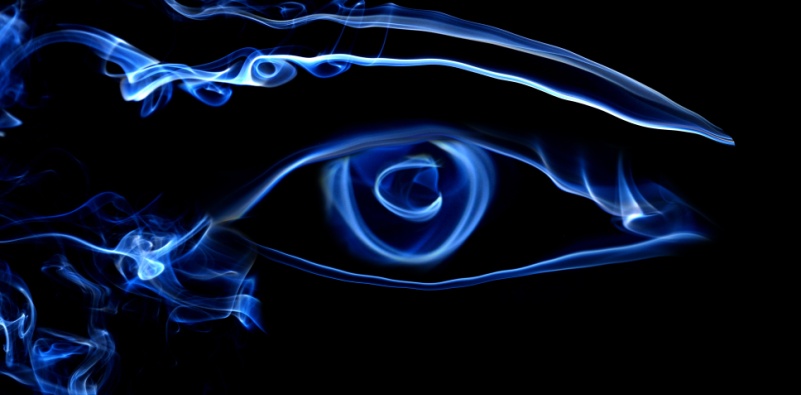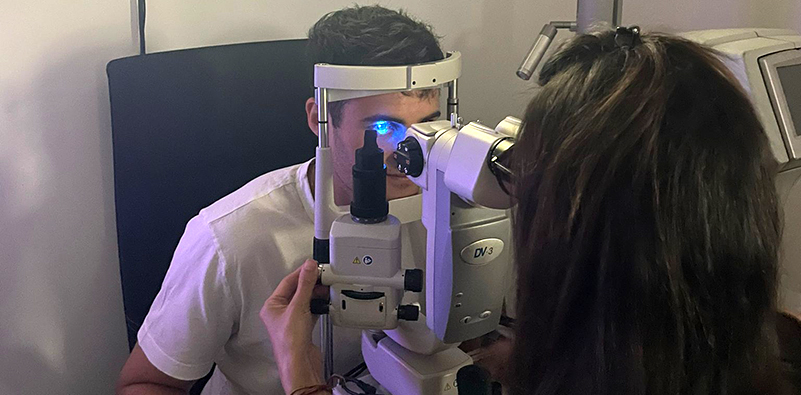Understanding the link between smoking and eye health
If you’re a smoker and you want to protect the long-term health of your eyes, then read on.
Smoking has long been recognised as a significant risk factor for various health issues, including respiratory problems, cardiovascular diseases, and certain types of cancer. However, did you know it can also have a detrimental impact on your eye health?
With an estimated 6.4 million smokers in the UK, let’s delve into the ways that smoking affects the eyes and the potential short and long-term consequences it can have on your vision and overall ocular health.
How does smoking affect your eyes?

Your eyes are a marvel of biology. The eyeball is a delicate structure that contains an intricate network of blood vessels that provide oxygen and nutrients to enable it to function.
Smoking exposes your eyes to the various harmful substances present in cigarette smoke, including nicotine, tar, carbon monoxide, and numerous other toxic chemicals.
These substances won’t do your eye health any favours. They can damage the tissue and blood vessels in your eyes, potentially leading to a range of problems – including increasing the chance of sight loss.
How smoking impacts contact lens wearers
If you’re a contact lens wearer, your lenses can be impacted by the chemicals in smoke (more on those later), discolouring them and forcing you to change them more frequently.
Contact lenses can also get contaminated with deposits from your fingers, potentially leading to a corneal ulcer and infections. The risk is exacerbated by the fact that smoking is known to hamper your immune system, making it easier for infections to develop.
Smoking and eye diseases
If you smoke, or you’re around second-hand smoke a lot, you’re at a higher risk of developing several eye conditions. These include:
Age-related macular degeneration (AMD) – Smokers are 4 times more likely to develop AMD than those who don’t smoke. AMD is a progressive condition that affects the macula – the central part of the retina. It can lead to central vision loss, making it difficult to read, drive, or recognise faces.
Cataracts – People who smoke are 2-3 times more likely to develop cataracts, a clouding of the lens in the eye due to a breakdown of the protein in the eye that can cause blurred vision and eventually lead to blindness if left untreated.
Diabetic retinopathy – Smoking can exacerbate the effects of diabetes on the eyes, increasing the risk and severity of diabetic retinopathy. This condition damages the blood vessels in the retina and can lead to vision loss if not managed properly.
Dry eye syndrome – Can smoking cause dry eyes? Unfortunately, yes. Smoking doubles your chance of suffering from dry eye syndrome, a condition characterised by insufficient tear production or poor tear quality. Tobacco smoke breaks down the lipid layer of the eye’s tear film, leading to symptoms such as redness, a gritty feeling, blurry vision, stinging, general discomfort, and other more serious effects. If you’re a contact lens wearer, smoke will exacerbate the symptoms of dry eyes, because it interferes with your tear film and can lead to increased evaporation of your tears. This can mean you’re not able to comfortably wear your contact lenses for as long as you would otherwise.
Glaucoma – Smoking is also linked to an increased risk of developing glaucoma. Glaucoma is a group of eye conditions that can lead to optic nerve damage and vision loss. Research suggests that smoking can elevate the pressure inside the eye (intraocular pressure), which is a major risk factor for glaucoma. In many cases, glaucoma has no symptoms until significant vision loss occurs.
Chemicals and compounds in tobacco smoke

Tobacco smoke contains more than 7,000 chemicals and compounds that enter your blood when you smoke a cigarette. These ingredients can damage the blood vessels and structure of the cells in your eyes. The harmful chemicals and compounds include:
- Nicotine – Nicotine isn’t just addictive, it can also constrict your blood vessels, including those in your eyes. This reduces blood flow, potentially causing damage to the optic nerve and retina.
- Tar – Tar is a sticky substance that forms when tobacco is burned. It contains various harmful chemicals, including polycyclic aromatic hydrocarbons (PAHs), which can contribute to inflammation in the eyes and damage to ocular tissue.
- Carbon Monoxide (CO) – CO is a toxic gas present in cigarette smoke. It reduces the amount of oxygen that can be carried by the blood, which reduces the oxygen supply to the eye tissues, including the optic nerve.
- Hydrogen cyanide – Hydrogen cyanide is another poisonous gas present in cigarette smoke. It can impact how your cells get energy and damage ocular tissues, contributing to vision problems and eye diseases.
- Formaldehyde – Formaldehyde is a carcinogenic substance found in cigarette smoke. It can irritate your eyes and mucous membranes, leading to inflammation, discomfort, and potential tissue damage.
The importance of eye examinations

Regular eye examinations should be an essential part of your eye healthcare routine. They mean any problems can be diagnosed early and treatment can begin before the condition has progressed too far.
Technology such as optical coherence tomography (OCT) is a non-invasive imaging technique used to visualise and analyse the structures the back of your eye. OCT enables our optometrists to examine your eyes in detail and diagnose smoking-related conditions, such as cataracts and macular degeneration.
If you’re a smoker, quitting will improve your eye health, protect your family and friends from second-hand smoke, and improve your bank balance.
Contact us
We encourage you to contact us for more information about taking care of your eye health and to book your next eye examination at our opticians in Potters Bar, Finchley, and Temple Fortune.
